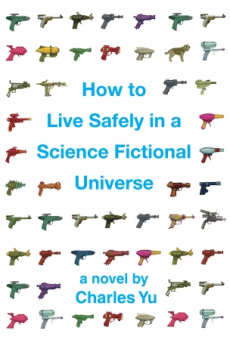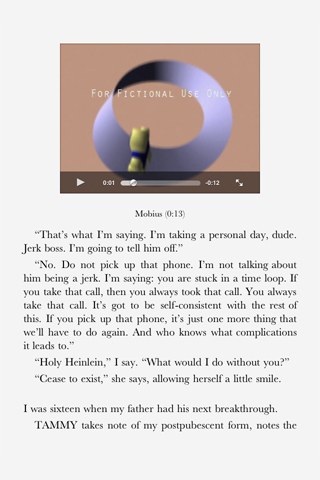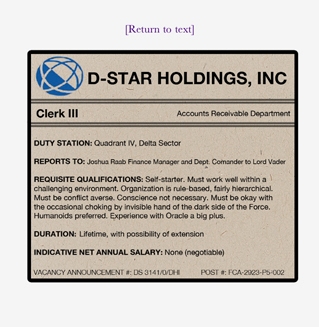Previously on the Nitty Gritty, we took a behind-the-scenes look at the process of development and rationale for Knopf's first enhanced e-book, Charles Yu's How to Live Safely in a Science Fictional Universe. But what about the actual reading experience? Do bells and whistles, video and links truly enhance a story--or distract from it?
 Reading
an e-book can be similar to reading a book: at the most basic level, you've got
words, in a particular order, by a particular writer. But as many readers will
tell you (some approvingly, others not), it never will be exactly the same
experience. A screen is not a page, a device is not a book, and trying to make them
the same thing is an exercise in futility. The modifications that digitization
allows the reader to make--from cosmetic user-controlled changes like shifting
the contrast, font size, page orientation, etc., to deliberate changes like
enhancements--inevitably alter the flow of how you read. But that isn't
necessarily a bad thing.
Reading
an e-book can be similar to reading a book: at the most basic level, you've got
words, in a particular order, by a particular writer. But as many readers will
tell you (some approvingly, others not), it never will be exactly the same
experience. A screen is not a page, a device is not a book, and trying to make them
the same thing is an exercise in futility. The modifications that digitization
allows the reader to make--from cosmetic user-controlled changes like shifting
the contrast, font size, page orientation, etc., to deliberate changes like
enhancements--inevitably alter the flow of how you read. But that isn't
necessarily a bad thing.
Reading
the enhanced e-book, I found that the extras slowed the flow. I'm a fast
reader, used to plowing through big chunks of text at breakneck speed. This is
an asset. I can read more books in less time. But it's also a liability:
sometimes I miss details or beautiful bits of writing because I'm looking ahead
to the next plot point. The links, videos and audio were a jolt, knocking me
out of my rhythm and forcing me to stop and click. It was comparable to reading
an annotated edition: the references break up the flow of the story in a
similar way, sending you off in slightly different directions mentally, while
still relating directly to the text.
ahead
to the next plot point. The links, videos and audio were a jolt, knocking me
out of my rhythm and forcing me to stop and click. It was comparable to reading
an annotated edition: the references break up the flow of the story in a
similar way, sending you off in slightly different directions mentally, while
still relating directly to the text.
But the enhancements are neat. Because this book is so concept-heavy (time travel!), it lends itself to extras that build on and supplement the text, rather than merely illustrating or repeating the text in a visual/audio form. (Confession: I've always disliked those call-outs in magazines that repeat sentences, only in a bigger, fancier font, and I was afraid that the add-ons would be the same thing, but worse, because you'd have to stop and click them just to find out that it was more of the same.) So I tip my hat to the author and team for a gamble well-played.
 The enhanced e-book can also help booksellers handsell. With a customer, I can whip out my iPod and say, "Check it out! It's got this
funny bit about the Death Star in it!" and show the funny bit (see left). And with the arrival of more ways for indies to sell e-books, I believe that booksellers will start to find themselves
handselling them sooner rather than later.
The enhanced e-book can also help booksellers handsell. With a customer, I can whip out my iPod and say, "Check it out! It's got this
funny bit about the Death Star in it!" and show the funny bit (see left). And with the arrival of more ways for indies to sell e-books, I believe that booksellers will start to find themselves
handselling them sooner rather than later.
For me, the enhancements in How to Live Safely in a Science Fictional Universe added a new dimension to the reading experience and played to the book's strengths--its sci-fi roots, its use of concepts, its ability to take abstract theories and make them incredibly, sometimes painfully, personal. If you like reading annotated editions, you'll probably enjoy enhanced e-books. If you prefer your story straight-up and straight-forward, you'll likely want to skip them.
Side note: while I have a wish list of other books that I'd love to see receive similar treatment (one of them is another Knopf title, A Visit from the Goon Squad by Jennifer Egan, that is just begging for an integrated play list and a fully interactive slideshow), I also think that many books might suffer from this kind of enhancement. It's a brave new digital world out there, and my hope is that publishers and authors will try a lot of different things, but will tailor these experiments to the books themselves in the same way that they tailor the jacket. Not every book needs a girl in period costume on the cover, and not every e-book needs embedded video.--Jenn Northington

